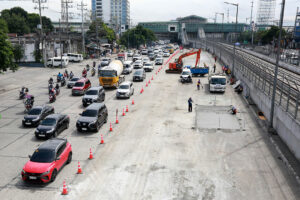By Beatriz Marie D. Cruz, Reporter
THE NATIONAL Government’s (NG) spending on infrastructure jumped by 17% in June as it increased disbursements for completed public works projects, the Department of Budget and Management (DBM) said.
In its latest report, the DBM said infrastructure and other capital outlays rose by 17% to P139.7 billion in June from P119.4 billion in the same month a year ago.
Month on month, infrastructure spending inched up by 2.45% from P136.4 billion in May.
The uptick in June infrastructure spending was attributed to “disbursements made by the DPWH (Department of Public Works and Highways) for completed road, bridge and multi-purpose building projects, prior years of right-of-way claims, and progress billings for other road infrastructure projects funded under the Unprogrammed Appropriations,” the DBM said.
The NG also spent on capital outlay projects under the Department of National Defense’s Revised Armed Forces of the Philippines Modernization Program.
In June, infrastructure spending included locally funded projects under the Office of the Presidential Adviser on the Peace, Reconciliation and Unity’s PAyapa at MAsaganang PamayaNAn (PAMANA) Program such as road networks, flood control, and water supply systems, among others.
The government also spent on the construction, repair and rehabilitation of justice halls nationwide.
Ruben Carlo O. Asuncion, chief economist at Union Bank of the Philippines, Inc., said the uptick in infrastructure spending in June was reflected in the faster second-quarter economic growth.
“The government pushed to spend and supported domestic demand weakness in the second quarter amid the El Niño impact and elevated interest rates,” he said in a Viber message.
Preliminary data released by the Philippine Statistics Authority (PSA) showed gross domestic product (GDP) expanded by an annual 6.3% in the April-to-June period, quicker than the revised 5.8% growth in the first quarter and 4.3% in the second quarter of 2023.
PSA data also showed government spending rose by 10.7% in the second quarter, a reversal of the 7.1% contraction a year earlier.
“Preparations for the midterm elections may have also increased the urgency to expedite the rollout and completion of more infrastructure projects before the election ban by early 2025, and to show more accomplishments/results that may be felt by the electorate,” Rizal Commercial Banking Corp. Chief Economist Michael L. Ricafort said in a Facebook Messenger chat.
FIRST HALFFor the first half, infrastructure and other capital outlays increased by 20.6% to P611.8 billion from P507.2 billion a year ago.
This exceeded the P545.3-billion program for the period by 12.2% “as a result of the efforts of the DPWH to speed up the completion of its ongoing projects and expedite the processing of payment claims both from prior year’s obligations and the current year’s budget,” the DBM said.
The DBM also said there were direct payments made for foreign-assisted road and rail transport projects under the Public Works and Transporation departments in the first half.
“As early as January, we already provided them (implementing agencies) their allotments and most of the DPWH projects were already undergoing early procurement… By January, they already implemented most of the projects,” Budget Secretary Amenah F. Pangandaman told a briefing on Wednesday.
Overall infrastructure disbursements, which also accounted for the infrastructure components of transfers to local government units (LGUs), and subsidy and equity to government-owned and -controlled corporations, rose by 18.4% to P720.5 billion as of end-June from P608.6 billion last year.
This exceeded the government’s P671.3-billion program for the period by 7.33%, data showed. It was also equivalent to 5.7% of gross domestic product (GDP).
“Infrastructure spending and MOOE (maintenance and other operating expenses) will continue to drive disbursements for the remaining months of the year, with 56.1% and nearly 52% of their full-year program, respectively, expected this second semester,” the DBM said.
For infrastructure spending, the DBM said this includes payments for ongoing construction works.
“The said expenditures will hopefully help buttress strong economic growth by creating demand in the construction sector or supporting other related services industries, while also facilitating the recovery of the agriculture sector,” the department said.
Terry L. Ridon, a public investment analyst and convenor of think tank InfraWatch PH, said he expects infrastructure spending to further increase this year.
“Infrastructure agencies should try their best to improve their absorptive capacities for this year’s projects, particularly as 2025 is an election year in which the law mandates a suspension of project implementation for a specific period of time,” he said in a Viber chat.
Mr. Asuncion said the government should focus spending on infrastructure, flood control and energy generation projects.
“The challenge is that it would take time to put new projects up and going,” he said.
The government aims to spend 5-6% of GDP annually for infrastructure through 2028.
